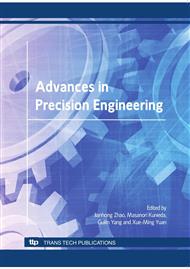p.51
p.55
p.61
p.66
p.71
p.76
p.81
p.86
p.91
Achieving High Flatness of Workpiece Edge Shape by Considering Polishing Pressure
Abstract:
In recent years, the achievement of further high flatness of workpiece edge shape is strongly required in mirror finishing. Especially, the edge roll off of silicon wafers as the substrates of semiconductor devices is demanded to decrease in the polishing process for raising the yield of IC chips. Many theoretical and experimental analyses for the edge roll off generation have been already done to meet the demand. The analyses, however, cannot fully account for the obtained edge shape in actual polishing. Concretely, the influence of the polishing pressure as one of the key polishing conditions on the edge roll off has not been clarified. In this study, the influence of the polishing pressure on the edge shape was investigated by the polishing experiments and the edge roll off generation analyses using the model based on the viscoelasticity of the polishing pad, which was proposed in the previous study. And it was revealed that an appropriate polishing pressure is needed to be set for achieving high flatness of workpiece edge shape with the consideration of the properties of applied polishing pads.
Info:
Periodical:
Pages:
71-75
Citation:
Online since:
September 2010
Authors:
Keywords:
Price:
Сopyright:
© 2010 Trans Tech Publications Ltd. All Rights Reserved
Share:
Citation:


